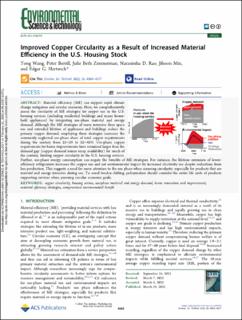| dc.contributor.author | Wang, Tong | |
| dc.contributor.author | Berrill, Peter | |
| dc.contributor.author | Zimmerman, Julie Beth | |
| dc.contributor.author | Rao, Narasimha D. | |
| dc.contributor.author | Min, Jihoon | |
| dc.contributor.author | Hertwich, Edgar G. | |
| dc.date.accessioned | 2023-02-21T09:14:22Z | |
| dc.date.available | 2023-02-21T09:14:22Z | |
| dc.date.created | 2022-05-04T14:20:05Z | |
| dc.date.issued | 2022 | |
| dc.identifier.citation | Environmental Science and Technology. 2022, 56 (7), 4565-4577. | en_US |
| dc.identifier.issn | 0013-936X | |
| dc.identifier.uri | https://hdl.handle.net/11250/3052628 | |
| dc.description.abstract | Material efficiency (ME) can support rapid climate change mitigation and circular economy. Here, we comprehensively assess the circularity of ME strategies for copper use in the U.S. housing services (including residential buildings and major household appliances) by integrating use-phase material and energy demand. Although the ME strategies of more intensive floor space use and extended lifetime of appliances and buildings reduce the primary copper demand, employing these strategies increases the commonly neglected use-phase share of total copper requirements during the century from 23–28 to 22–42%. Use-phase copper requirements for home improvements have remained larger than the demand gap (copper demand minus scrap availability) for much of the century, limiting copper circularity in the U.S. housing services. Further, use-phase energy consumption can negate the benefits of ME strategies. For instance, the lifetime extension of lower-efficiency refrigerators increases the copper use and net environmental impact by increased electricity use despite reductions from less production. This suggests a need for more attention to the use phase when assessing circularity, especially for products that are material and energy intensive during use. To avoid burden shifting, policymakers should consider the entire life cycle of products supporting services when pursuing circular economy goals. | en_US |
| dc.language.iso | eng | en_US |
| dc.publisher | American Chemical Society | en_US |
| dc.relation.uri | https://pubs.acs.org/doi/full/10.1021/acs.est.1c06474 | |
| dc.rights | Navngivelse 4.0 Internasjonal | * |
| dc.rights.uri | http://creativecommons.org/licenses/by/4.0/deed.no | * |
| dc.title | Improved Copper Circularity as a Result of Increased Material Efficiency in the U.S. Housing Stock | en_US |
| dc.title.alternative | Improved Copper Circularity as a Result of Increased Material Efficiency in the U.S. Housing Stock | en_US |
| dc.type | Peer reviewed | en_US |
| dc.type | Journal article | en_US |
| dc.description.version | acceptedVersion | en_US |
| dc.source.pagenumber | 4565-4577 | en_US |
| dc.source.volume | 56 | en_US |
| dc.source.journal | Environmental Science and Technology | en_US |
| dc.source.issue | 7 | en_US |
| dc.identifier.doi | 10.1021/acs.est.1c06474 | |
| dc.identifier.cristin | 2021478 | |
| dc.relation.project | Norges forskningsråd: 300330 | en_US |
| cristin.ispublished | true | |
| cristin.fulltext | postprint | |
| cristin.qualitycode | 2 | |

